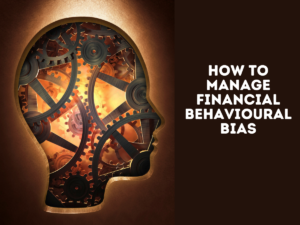
By Steve Lowrie, CFA
Special to Financial Independence Hub
There are countless external forces influencing your investment outcomes: taxes, market mood swings, breaking news, etc., etc.
Today, let’s look inward, to an equally important influence: your own financial behavioural biases.
The Dark Side of Financial Behavioural Bias
Having evolved over millennia to secure our survival, our deep-seated behavioural biases precondition us to frequently depend more on “gut feel” than rational reflection. Sometimes, our instincts are life-saving, like when a car brakes hard right in front of you. Chemical reactions in the lower brain’s amygdala trigger you to brake too, even as your higher brain is still enjoying the scenery.
Unfortunately, these same rapid-fire triggers often hurt us as investors. When we make snap financial decisions that “feel” right but are rationally wrong, we tend to sabotage our own best interests. By recognizing these reactions as they occur, you’re more likely to stop them from ruining your financial resolve, which in turn improves your odds for better outcomes. Let’s explore some behavioural finance examples that you’ll want to prepare for…
Behavioural Finance Example #1: Fear and FOMO
The point of investing is to buy low and sell high. So, why do so many investors so often do the opposite? You can blame fear, as well as Fear of Missing Out (FOMO investing). Time after time, crisis after crisis, bubble after bubble, investors rush to buy high by chasing hot holdings. They hurry to sell low, fleeing falling prices. They’re letting their behavioural biases overcome their rational resolve.
Behavioural Finance Example #2: Choice Overload and Decision Fatigue
Our brains also don’t deal well with too much information. When we experience information overload, we may stop even trying to be thoughtful, and surrender to our biases. We’ll end up favouring whatever’s most familiar, most recently outperforming, or least scary right now. When choosing from an oversized restaurant menu, that’s okay. But your life savings deserve better than that.
Behavioural Finance Example #3: Popular Demand and Survival of the Fittest
Inherently tribal by nature, we humans are susceptible to herd mentality. When everyone else gets excited and starts chasing fads, whether it is cryptocurrencies, alternative investments, or the other financial exotica-du-jour, we want to pile in too. When the herd turns tail, we want to rush after them. It’s like that old joke about escaping a bear: you don’t need to run faster than the bear; you just need to run faster than the guy next to you. In bear markets, this causes investors to flee otherwise sound positions, selling low, and paying dearly for “safer” holdings, rather than holding their well-planned ground.
Behavioural Finance Example #4: Anchor Points and Other Financial Regrets
Successful investors look past their occasional setbacks and remain focused on capturing the market’s long-term expected returns. But that’s hard to do, as we are often trapped by financial decisions regret. For example, loss aversion causes the average investor to regret losing money approximately twice as much as they appreciate gaining it. Similarly, anchor bias causes us to cling to depreciated holdings long after they no longer make sense in our portfolio, hoping against hope they’ll eventually recover to some arbitrary, past price. Ironically, you’re less likely to achieve your personal financial goals if you’re driven more by your financial regrets than your willpower.
Taking Charge of Your Financial Behavioural Biases
We’ve now looked at some of the damage done by behavioural biases. Once you know they’re there, you can at least minimize your exposure to them. Better yet, by using what behavioral psychologists call “nudges,” you can even harness your biases as forces for financial good. Following are two examples.
A Choice Nudge: Our tendency toward financial decision fatigue means, the more choices we must make, the sloppier our choices become. Why not use that insight to your advantage? If you’re comparing two equally appropriate investment portfolios, and one is easier to build and maintain than the other, choose the simpler one, and you’re likely to be better off for it.
These days, there are simple, low-cost investing solutions available to do just that. First, plan your own ideal investment mix according to these three key decisions:

Next, create a low-cost, globally diversified portfolio that embodies your personalized financial plan. A perfectly good and simple investing solution can contain two well-built index or enhanced index funds: one for global fixed income, and the other for global equities.
Remember this nudge next time you’re fretting over an over-sized menu of investment choices and investment types. Two selections can set you straight.
Auto-Pilot Action: In his best-seller Nudge, Nobel laureate Richard Thaler describes, when U.S. employees have to take action to enroll in their employer’s retirement plan, participation and savings rates tend to be low. More recently, many employers have started auto-enrolling employees in their plan and increasing their contribution rates annually. Employees are free to opt out if they DON’T want to participate, but if they take advantage of the nudge, their retirement savings rates typically improve.
As an individual investor, there are countless ways you can use similar nudges to improve your financial outcomes. For example, you could have a portion of your monthly paycheck auto-deposited and invested in your RRSP or TFSA before natural tendencies kick in and you end up spending it all instead.
Managing Your Behavioural Biases, for Better or Worse
We’ve come a long way toward understanding investors’ behavioural biases since I became a financial professional back in the 1990s. At the time, behavioural finance was still in relative academic infancy. Financial journalists rarely covered the topic. Professional financial organizations did not usually include it in their credentialing programs.
Today, I’m happy to see much more widespread attention given to this very human side of investing. Still, even before behavioural finance had a name, I saw how often my clients’ instincts and emotions got in the way of their own best interests. I realized their success or failure usually hinged on how well or poorly we managed these inner demons. I recognized how investment instincts could be among our most powerful allies or worst enemies, depending on who was in charge of them.
So, what’s really going on inside your head as you make critical decisions about managing your money? By considering this pivotal question each time you’re tempted to react to the latest news, you stand a much better chance of being the boss of your investment outcomes.
Then again, blind-spot bias is another common trap. It renders us unable to see our own cognitive errors, even when we can readily see them in others. This is why, here at Lowrie Financial, we’re not only keen to educate investors about behavioural finance, we also try to shine a spotlight on behavioural biases as they occur. Please be in touch if you’d like to learn more about financial behavioural bias.
 Steve Lowrie holds the CFA designation and has 25 years of experience dealing with individual investors. Before creating Lowrie Financial in 2009, he worked at various Bay Street brokerage firms both as an advisor and in management. “I help investors ignore the Wall and Bay Street hype and hysteria, and focus on what’s best for themselves.” This blog originally appeared on his site on May 1, 2023 and is republished here with permission.
Steve Lowrie holds the CFA designation and has 25 years of experience dealing with individual investors. Before creating Lowrie Financial in 2009, he worked at various Bay Street brokerage firms both as an advisor and in management. “I help investors ignore the Wall and Bay Street hype and hysteria, and focus on what’s best for themselves.” This blog originally appeared on his site on May 1, 2023 and is republished here with permission.
Share this:
- Click to share on X (Opens in new window) X
- Click to share on LinkedIn (Opens in new window) LinkedIn
- Click to share on Facebook (Opens in new window) Facebook
- Click to share on Reddit (Opens in new window) Reddit
- Click to email a link to a friend (Opens in new window) Email
- Click to print (Opens in new window) Print

